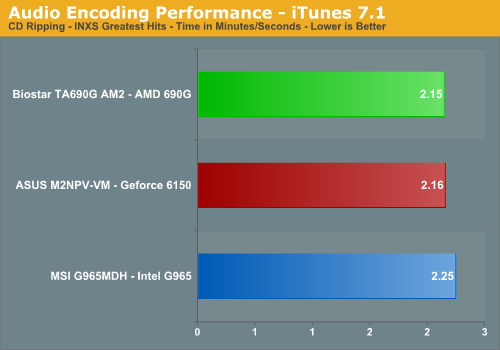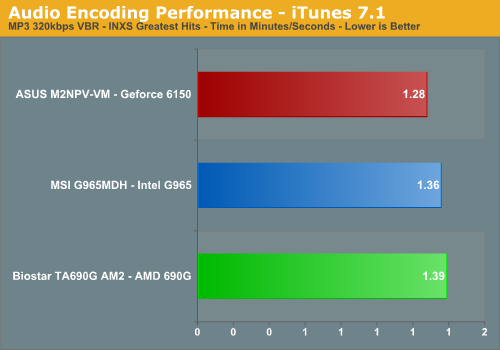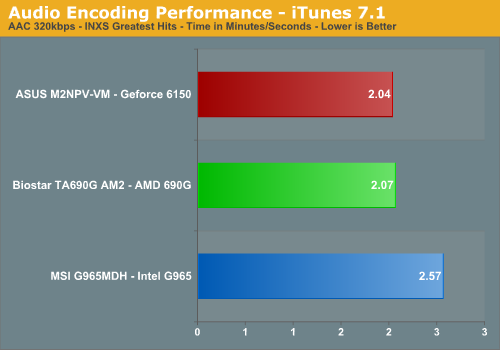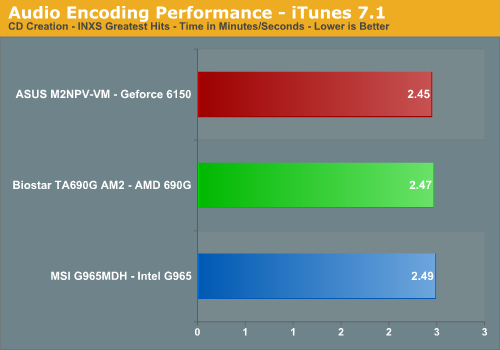Audio Encoding Performance
While the media encoding prowess of the Intel platform seemed to be lacking at times, we expect it to fair a little better on the audio side. Our audio test suite normally consists of Exact Audio Copy v095.b4 and LAME 3.98a3. We did run these tests with basically the same results but for our purposes today we will utilize iTunes 7.1 as it is one of the most utilized audio applications available due to the immense popularity of the iPod.
Our first task was to figure out what test CD to utilize. We needed one that contained a significant number of tracks and had over 600MB of data in order to properly stress our platforms. After rummaging around the lab and discounting the Burl Ives Greatest Christmas Hits album, we happened upon a CD that would work for our purposes as it was not working for anyone else, INXS Greatest Hits. This one time '80s glory masterpiece contains 16 tracks totaling 606MB of songs that was instantly whisked into our anxiously awaiting optical drive.
Our first test consists of utilizing iTunes to rip our INXS CD to WAV format on our hard drive. Even though CPU speed and optical drive selection have a great impact on these test results we are using the same optical drive between platforms for each test.

Our two AM2 platforms score slightly ahead of our Intel setup but the margin is minimal. This test was very consistent with each result never varying more than one second from the base score. Unlike the Nero Recode 2 DVD burning test, in this case our AMD systems did not suffer from drive issues.
Our next two tests have us utilizing iTunes to convert our WAV files into ACC or MP3 compatible formats. We utilize the 320kbps setting for both tests with the MP3 test also utilizing the variable bit rate option.


We usually see iTunes favoring the AM2 platforms in most test results. The results are no different here with both AM2 systems completing the ACC conversion about 50 seconds before the Intel system. In our MP3 conversion, the Intel system places second but the general differences are minimal. We attribute the 6150 performance to better storage controller and CPU throughput although standard memory bandwidth is lower than the other two boards.
Our final test has us creating a legal use copy CD from the base WAV files we collected when ripping the INXS Greatest Hits CD. Not that the world needs anymore of these CDs but it makes for a good closing test. We promise all CDs are destroyed after testing (much to the pleasure of our ears and those at the RIAA).

Once again our test results are extremely close with the optical drive playing a leading role in ensuring our results are fairly close. The minor differences are all attributable to the better disk performance of the NIVIDA 6150/430 combination in this case. We noticed each time that the disk access stopped about two to three seconds quicker with the 6150 platform. This is opposite of our Video Encoding results where each of our AM2 platforms could not keep the optical drive fed properly over the course of a burn session.
While the media encoding prowess of the Intel platform seemed to be lacking at times, we expect it to fair a little better on the audio side. Our audio test suite normally consists of Exact Audio Copy v095.b4 and LAME 3.98a3. We did run these tests with basically the same results but for our purposes today we will utilize iTunes 7.1 as it is one of the most utilized audio applications available due to the immense popularity of the iPod.
Our first task was to figure out what test CD to utilize. We needed one that contained a significant number of tracks and had over 600MB of data in order to properly stress our platforms. After rummaging around the lab and discounting the Burl Ives Greatest Christmas Hits album, we happened upon a CD that would work for our purposes as it was not working for anyone else, INXS Greatest Hits. This one time '80s glory masterpiece contains 16 tracks totaling 606MB of songs that was instantly whisked into our anxiously awaiting optical drive.
Our first test consists of utilizing iTunes to rip our INXS CD to WAV format on our hard drive. Even though CPU speed and optical drive selection have a great impact on these test results we are using the same optical drive between platforms for each test.

Our two AM2 platforms score slightly ahead of our Intel setup but the margin is minimal. This test was very consistent with each result never varying more than one second from the base score. Unlike the Nero Recode 2 DVD burning test, in this case our AMD systems did not suffer from drive issues.
Our next two tests have us utilizing iTunes to convert our WAV files into ACC or MP3 compatible formats. We utilize the 320kbps setting for both tests with the MP3 test also utilizing the variable bit rate option.


We usually see iTunes favoring the AM2 platforms in most test results. The results are no different here with both AM2 systems completing the ACC conversion about 50 seconds before the Intel system. In our MP3 conversion, the Intel system places second but the general differences are minimal. We attribute the 6150 performance to better storage controller and CPU throughput although standard memory bandwidth is lower than the other two boards.
Our final test has us creating a legal use copy CD from the base WAV files we collected when ripping the INXS Greatest Hits CD. Not that the world needs anymore of these CDs but it makes for a good closing test. We promise all CDs are destroyed after testing (much to the pleasure of our ears and those at the RIAA).

Once again our test results are extremely close with the optical drive playing a leading role in ensuring our results are fairly close. The minor differences are all attributable to the better disk performance of the NIVIDA 6150/430 combination in this case. We noticed each time that the disk access stopped about two to three seconds quicker with the 6150 platform. This is opposite of our Video Encoding results where each of our AM2 platforms could not keep the optical drive fed properly over the course of a burn session.










70 Comments
View All Comments
SignalPST - Tuesday, March 6, 2007 - link
I'm interested in this topic as well.Then again, I still waiting for them to come out with a HDMI sound card.
StriderGT - Wednesday, March 7, 2007 - link
Unfortunately there are lots of us who are still waiting for a true HDMI PC audio solution. You can check the thread I started with many technical details for that matter here: http://www.avsforum.com/avs-vb/showthread.php?t=79...">http://www.avsforum.com/avs-vb/showthread.php?t=79...Patrese - Tuesday, March 6, 2007 - link
Great review, thanks... I know I asked that a couple times already, but is there a mATX roundup planned here at AT? I'd like to see the Asus M2NPV-VM and Abit NF-M2 NView compared with its 690G counterparts, as this segment makes for most of the computer sales on most places? BTW, weren't you plaged by memory compatibility issues with the M2NPV-VM oe any of the boards tested? This Asus board showed extremely picky on my experience...Gary Key - Wednesday, March 7, 2007 - link
The roundup is scheduled on the 19th, trying to pull it in. What BIOS and memory are you using on the M2NPV-VM, so far I have not run into any real issues except with 2GB modules. The abit board is one of my favorites so far. ;)Patrese - Tuesday, March 6, 2007 - link
There shouldn't be a question mark at the end of the "most sales" phrase... There are also a couple typos, sorry about that. Where's the edit button anyway? ;)RamarC - Tuesday, March 6, 2007 - link
i don't really understand the point of comparing chipsets/motherboards between processor families. subsystem performance figures can show glaring deficiencies but otherwise it really boils down to a cpu comparison. the "media/audio encoding" and "media performance" sections are certainly cpu-centric. and pitting a $230 x2 5200+ against a $185 e6300 winds up handicapping the intel contestant. shouldn't the $222 e6400 have been used instead?Gary Key - Tuesday, March 6, 2007 - link
As stated in the article, AMD is marketing the AM2 and 690G/V as a platform design to compete against the G/Q965 and Core 2 Duo solution. The 690G is targeted to the multimedia, HTPC, home/office, casual gaming crowd and was tested as such. We looked at the total price of a base Core 2 Duo and decent G965 board and then matched the processor choice that would come closest to the price and performance of the Intel offering while meeting the platform cost. Our tests were chosen based upon the target audience for each platform in the home environment. This was not a review of office level machines as the Q965/963 and 690V are targeted to the business user.JarredWalton - Tuesday, March 6, 2007 - link
The conclusion mentions that the G965 + E6300 costs around $300 compared to $315 for the 690G + 5200+ (or 6150 + 5200+), so it's more or less a fair "equivalent price" platform comparison. The E6400 ends up being faster than the E6300, but still slower in a few tests (as the text mentions) and even faster in those tests where E6300 already holds the lead. Nothing new there - we've pretty much beat the "Core 2 Duo is faster" drum to death. We feel anyone looking at 690G is going to be interested in the platform as a whole much more than whether or not it is faster than equivalently price Core 2 offerings.mostlyprudent - Tuesday, March 6, 2007 - link
There may be too many variables, but perhaps you could come up with a way to normalize the benchmarks. For instance, run the gaming tests first with ultra high-end graphics to try and isolate the performance delta for each plattofrm/cpu combo you will test with. Then run the game benchmarks with the IGP solutions and adjust the scores based on the previous tests. Just a thought off the top of my head.asliarun - Tuesday, March 6, 2007 - link
Ah, but you're evaluating a chipset here, not a platform or a system solution. Having said that, I agree that it IS difficult to compare chipsets that are targeted for different CPUs. In such a case, a better way to evaluate might be to take an AMD and an Intel CPU that is similar in performance (not in price), and use them to compare their corresponding chipsets. That would highlight the differences between the chipsets. You could always mention the price alongside, or do a separate price/performance comparison alongside.My point is that a price/performance comparison should complement a pure performance comparison, not the other way around.